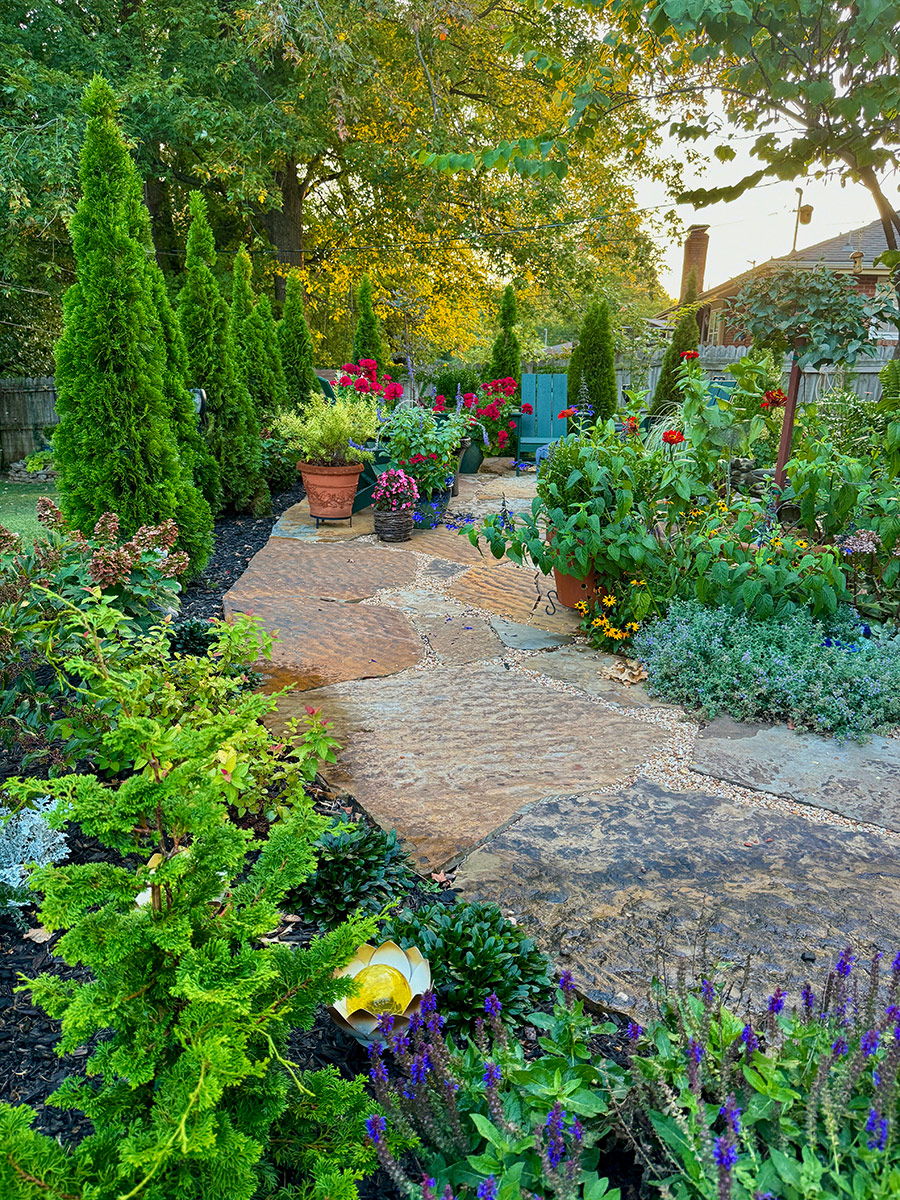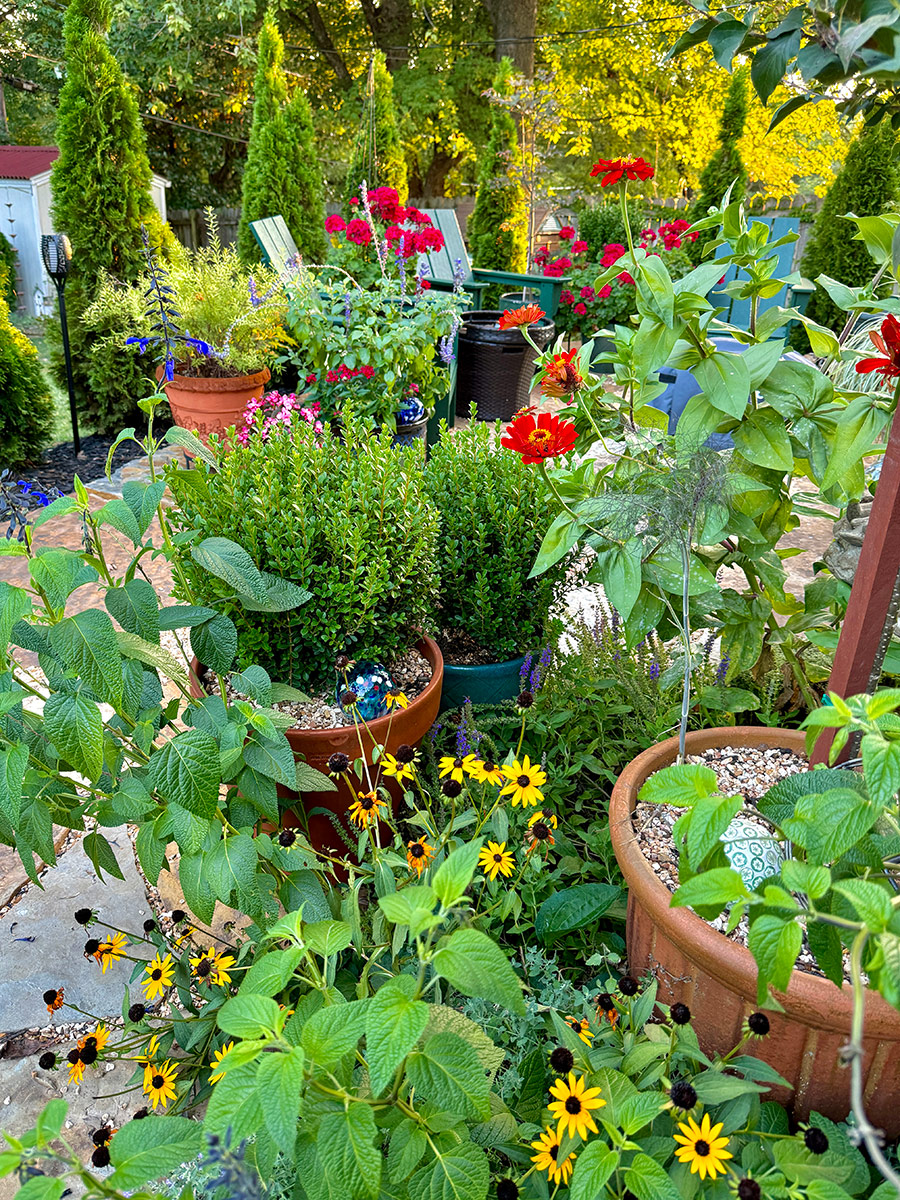
Happy Monday GPODers!
I’m very excited to start the week back in the garden of Suzannah Pugh. Several weeks back, I shared a couple photos Suzannah sent over in compilation post that featured two other gardens (check that out here). The little snippet we got to see of her space was magical, and I was eager to see more. Over the past couple weeks I was thrilled when I saw a handful of emails come in from Suzannah, showcasing different aspects of her garden and how they came to be. I finally had the chance to gather all of her submissions together, and below is a gorgeous tour through her small space and the changes that shaped it over the years.
Hello! I’m Suzannah Dolanc Pugh. I have a .36 acre yard in Springfield, Missouri, garden zone 6b.
I wanted to share some photos of what I call my “Swing Garden.” This garden was imagined after losing a very large silver maple tree (Acer saccharinum, Zones 3–9). Half of the yard, including the swing and play-set that my children played on daily went from full shade to full sun. I mourned the loss of the tree for several weeks, and then started to feel a bit of excitement over creating and imagining a whole new, and very sunny space. We did plant a very large red oak to replace the maple, but we won’t have shade for many years now. The garden area was executed in several phases over the next few years.

 The first year after the tree was gone, we planted new trees and had a permanent swing structure and an arbor installed. I knew I wanted to make a pollinator garden around the new swing structure, so we started with some echinacea, and some flowering shrubs: Pink ‘Polka’ weigela (Weigela florida ‘Polka’, Zones 4–9) and a Chinese snowball viburnum (Viburnum macrocephalum, Zones 7–9). The second year we added the picket fencing, raised garden beds, five Taylor junipers (Juniperus virginiana ‘Taylor’, Zones 3–9), smokebush (Cotinus coggygria, Zones 4–8), maiden hair grasses (Miscanthus sinensis ‘Gracillimus’, Zones 4–9), ‘Color Guard’ yucca (Yucca filamentosa ‘Color Guard’, Zones 5–10), and herbs, vegetables and cutting flowers. The third year we added herbaceous perennials. Salvias, rudbeckia, nepetas, phlox, lambs ear and many more.
The first year after the tree was gone, we planted new trees and had a permanent swing structure and an arbor installed. I knew I wanted to make a pollinator garden around the new swing structure, so we started with some echinacea, and some flowering shrubs: Pink ‘Polka’ weigela (Weigela florida ‘Polka’, Zones 4–9) and a Chinese snowball viburnum (Viburnum macrocephalum, Zones 7–9). The second year we added the picket fencing, raised garden beds, five Taylor junipers (Juniperus virginiana ‘Taylor’, Zones 3–9), smokebush (Cotinus coggygria, Zones 4–8), maiden hair grasses (Miscanthus sinensis ‘Gracillimus’, Zones 4–9), ‘Color Guard’ yucca (Yucca filamentosa ‘Color Guard’, Zones 5–10), and herbs, vegetables and cutting flowers. The third year we added herbaceous perennials. Salvias, rudbeckia, nepetas, phlox, lambs ear and many more.

The photo above is of my patio garden. It was constructed with large slabs of Arkansas stone and pea gravel. Smaller Arkansas stones are used as stepping stones in the foreground. To highlight the cobalt blue of the fountain, I planted ‘Black and Blue’ cobalt salvia (Salvia guaranitica ‘Black and Blue’, Zones 8–10 or as an annual). You might also notice some pops of blue ornamentation hiding in the ‘Cat’s Meow’ nepeta (Nepeta × faassenii ‘Cat’s Meow’, Zones 3–8) and ajuga. The mix of blue and yellow ‘American Gold Rush’ rudbeckia (Rudbeckia ‘American Gold Rush’, Zones 3–9) might be my favorite part!

We had several reasons for wanting to create a second patio area off of the existing patio. First of all, a designated fire pit area is very nice. Until we had this patio, we sat in our driveway with the firepit and folding chairs. It was fine, but didn’t quite have the aesthetic benefits that gardening can provide! Another reasons for the second space was to locate a shadier spot for the late afternoon and early evening hours when we often found ourselves wanting to use the patio. The existing patio, even with its roof, doesn’t keep out that intense, and hot, lower evening sun. Shifting the new patio over gave us the benefit of very filtered light and much cooler temperatures. The last added benefit of the area is that it helped to break up our large, very square back yard. The added Emerald Green arborvitae (Thuja occidentalis ‘Emerald Green’, Zones 3–8) and plant border, makes this patio area feel secluded from the rest of the yard.
In the photo above, you can see that the new patio has two oval gardens inside. One oval has a redbud tree that we planted when we made the patio. It’s large enough now it has coral bells, ferns and various ground covers underneath. The second oval area is sunny enough that I can grow sunny perennials like nepeta, rudbeckia, salvias, and annual zinnias.


Thank you for sharing more of your gorgeous garden with us, Suzannah! From the little peek we got to see before, I knew there were so many other fabulous sights to see. And I hope this encourages more GPOD readers to submit bits of their garden. Even if all you can share right now is one photo, I promise the rest of the GPOD community is eager to see what you’re growing!
Have a garden you’d like to share?
Have photos to share? We’d love to see your garden, a particular collection of plants you love, or a wonderful garden you had the chance to visit!
To submit, send 5-10 photos to gpod@taunton.com along with some information about the plants in the pictures and where you took the photos. We’d love to hear where you are located, how long you’ve been gardening, successes you are proud of, failures you learned from, hopes for the future, favorite plants, or funny stories from your garden.
Have a mobile phone? Tag your photos on Facebook, Instagram or Twitter with #FineGardening!
Do you receive the GPOD by email yet? Sign up here.
Fine Gardening Recommended Products

Berry & Bird Rabbiting Spade, Trenching Shovel
Fine Gardening receives a commission for items purchased through links on this site, including Amazon Associates and other affiliate advertising programs.

Spear & Jackson 4930FZ Razorsharp Telescopic Tree Pruner
Fine Gardening receives a commission for items purchased through links on this site, including Amazon Associates and other affiliate advertising programs.

SHOWA Atlas 370B Nitrile Palm Coating Gloves, Black, Medium (Pack of 12 Pairs)
Fine Gardening receives a commission for items purchased through links on this site, including Amazon Associates and other affiliate advertising programs.


















Comments
Really lovely.
A beautiful garden and great before and after photos. Also a nice thoughtful post on comparing children and gardening, a very nice thoughtful observation.
I love your garden and what a great flagstone path!
Also looks like your very large ---‘Black and Blue’ cobalt salvia (Salvia guaranitica ‘Black and Blue’, Zones 8–10 or as an annual).--- may have over-wintered and came back in spring like mine did in zone 6 b. Mine have been coming back for about 8 years now and are over 5 feet tall thriving as perennials, not annuals.
Again...such a beautiful post and garden!
Your garden is so happy! I love the planting around the swing area - makes it both fun and beautiful.
Log in or create an account to post a comment.
Sign up Log in